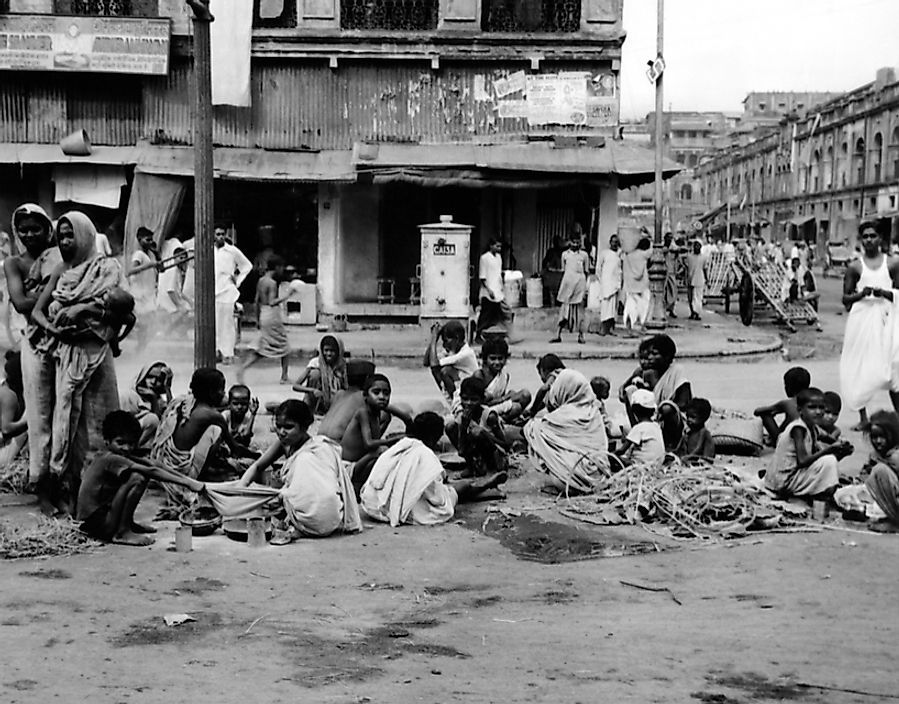The Bengal Famine of 1943

The Bengal famine was a severe famine that occurred in British India's Bengal Province in 1943, during World War II. The estimated number of victims that succumbed to death due to diseases, starvation, population displacement, malnutrition, lack of medical care, and the unsanitary environment is estimated at 2.1 million. With diseases such as dysentery, malaria, kala-azar, smallpox, and cholera, the Bengal Famine overwhelmed the citizens, affected large portions of the economy and social fabric, which further increased levels of inequality.
Background
Bengal was described as "a land of rice growers and rice eaters," since rice dominated agricultural activities in the province, making up about 75% of the crops harvested. Rice grown in Bengal accounted for almost 88% of the province’s arable land, and produced one-third of the rice in India. During this time, approximately 75% to 85% of daily food consumption came from rice. Fish was the second major food source, plus small amounts of wheat, and the consumption of other foods was comparatively low. Rice crops in Bengal are divided into three seasonal crops, the most important being the winter aman crop. The crop accounts for over 70% of rice grown in a year, and is grown between May and June, and then harvested in November and December. The aush or winter crop is second most important rice crop, accounting for over 20% of the year's harvest. Lastly, boro, also known as spring crop, accounted for small amounts of harvest. It is believed that a poor production of rice in 1942 during the all-important aman seasonal harvest lead to the Bengal famine.
Main Causes
The economy of Bengal was predominantly agrarian, and between half and three-quarters of the population depended on subsistence agriculture. Some of the underlying causes of the Bengal famine included dense population, inefficient agricultural practices, and de-peasantisation due to land grabbing and debt bondage. Other causes included natural disasters, impacts of the war, lost of imports due to the Japanese occupation of Burma, the disruption of the transport systems and the province’s market supplies. There were also high levels of inflation, failed policies, hoarding, war profiteering, and speculation.
Government Contributions
In addition to the factors listed above, the government also greatly invested in the country's military. High priority was given to defense and military services, at the expense of allocating medical care and food to the poor living in the rural areas. There were also constraints on domestic sources by the emergency inter-provincial trade barriers, denied accessibility to international sources by the War Cabinet of Great Britain, and restrictions to accessible grains, which together with the other factors contributed to the crisis resulting in the deaths of many men, women, and children.
Propaganda
The government of Bengal was slow to supply those affected with the required humanitarian aid. Initially, the government tried to use propaganda to discourage hoarding before attempting to reduce the price of rice through various procurement and price control schemes. These attempts only led to sellers withholding their produce and a thriving black market which further increased the cost of rice after the price controls failed. The government opted to offer relief efforts in the form of agricultural loans, test works, and gruel kitchens, which were ineffective and only worsened the food situation. Even though the country was equipped with a well-detailed Famine Code that could provided major increases in aid, Bengal’s provincial government did not officially declare a state of famine. The military took control of the crisis in October 1943, hence increasing relief efforts. However, Bengal received more effective aid following an improved rice harvest in December of that same year, leading to a decline in the number of deaths caused by starvation.
Socioeconomic Effects
The Bengal famine heavily accelerated existing levels of socioeconomic inequality and poverty, ruined Bengal’s economy and social fabric, and destroyed millions of families. Another observable effect was the selling off of assets for food. There was the unprecedented number of small-scale farmers who sold or mortgaged their land, either in part or in full, to save themselves. As a result, almost 1.6 million families, which is roughly ¼ of those who had farms before the famime, either sold or mortgaged their farms.











